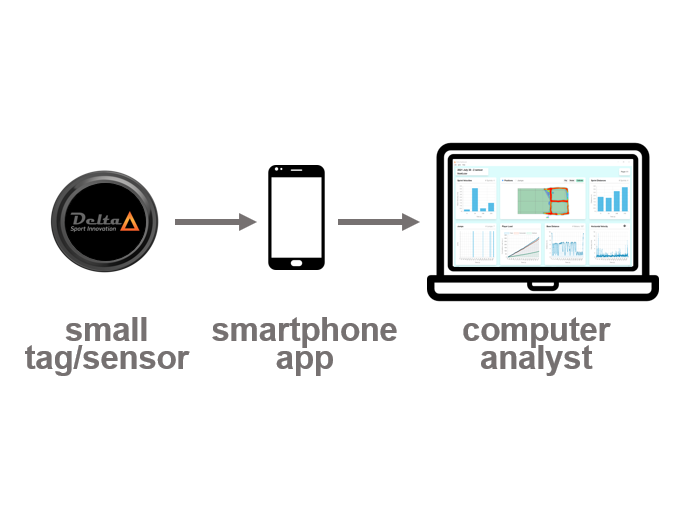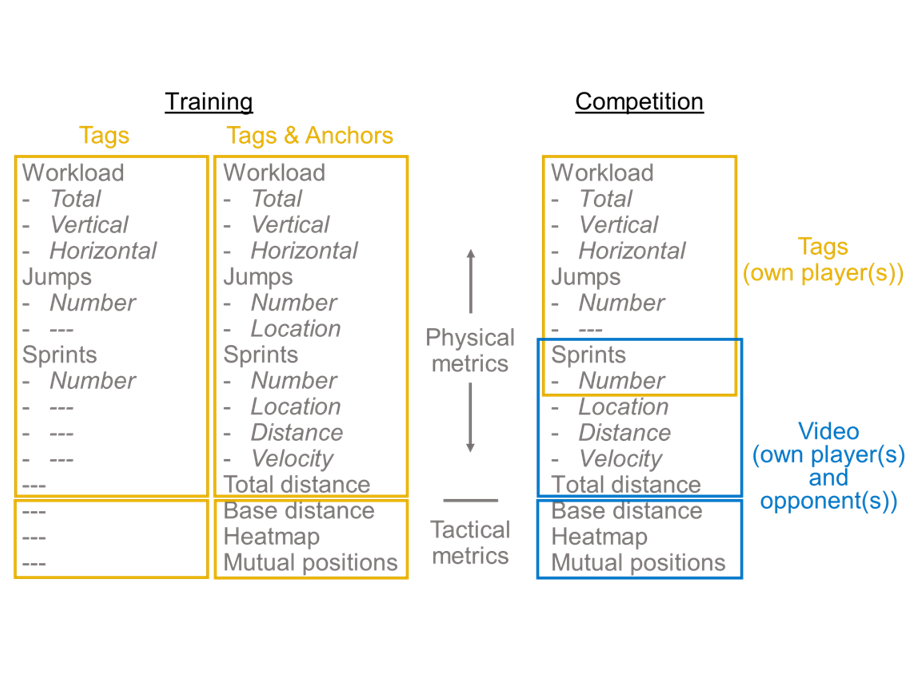Products
The products offered below are especially suited for sports characterized by physically challenging and demanding complex repetitive upper and lower extremity movements with constant postural variations, asking for short bursts of movement, sudden sharp changes of direction, lunges, sprints, reaches, retrievals, jumps and powerful strokes. Think of sports like badminton, tennis, padel, squash, beach volleyball, 3×3 basketball and more.
Our products

DeltaDashboard
System for workload monitoring. The athlete/player wears a small tag/sensor. Data acquired are transmitted to the analyst via a smartphone, resulting in physical metrics, i.e., on the external load of the training or competition session. Key metrics are to be used to monitor in particular the acute:chronic workload ratio on a week by week basis. The tag is also able to acquire heart rate data as a metric of internal load. Would you like to have more information or a quotation, please go to the contact page.
Load monitoring
The International Olympic Committee consensus statement on load in sport and risk of injury says that scientific monitoring of the athlete’s loads is key to successful load management, athlete adaptation and injury mitigation in sport (Soligard et al., 2016). Several of the committee’s recommendations are:
- Coaches and support staff are recommended to employ scientific methods to monitor the athlete’s load and detect meaningful change.
- Load should always be monitored individually.
- No single marker has been validated to identify when an athlete has entered a maladaptive state; hence, it is recommended to use a combination of external and internal load measures that are relevant and specific to the nature of each sport.
- Load is not an isolated variable, but must be monitored using a comprehensive approach taking into account interaction with and relative contributions from other intrinsic and extrinsic factors, such as injury history, physiological, psychological (e.g., non-sport loads), biochemical, immunological, environmental and genetic factors, as well as age and sex.
- Special consideration should be given to the monitoring of acute and chronic loads, and the acute:chronic load ratio of the individual athlete.
- Monitoring should be performed frequently (e.g., daily or weekly measures self-administered by the athlete) to enable acute adjustments to training and competition loads as required; however, with consideration given to minimising the burden on athletes.
Soligard T, Schwellnus M, Alonso J-M, Bahr R, Clarsen B, Dijkstra HP, Gabbett T, Gleeson M, Hägglund M, Hutchinson MR, Janse van Rensburg C, Khan KM, Meeusen R, Orchard JW, Pluim BM, Raftery M, Budgett R, Engebretsen L. How much is too much? (Part 1) International Olympic Committee consensus statement on load in sport and risk of injury. Br J Sports Med 2016; 50: 1030–1041.
External and internal load
External load typically involves quantifying the training or competition load of athletes (as well as their capabilities and capacities), while internal load is measured by assessing the physiological and psychological response to the external load (in the case of heart rate for instance determining in what heart rate zones the athlete was performing).
Acute:chronic workload ratio
Blanch and Gabbett (2016) demonstrated that the acute:chronic workload ratio explains 53% of likelihood of subsequent injury via a curved relationship. They stated that each type of loading for different sports will most likely require its own specific model. Their modelling clearly demonstrates that if athletes perform greater workloads than they are prepared for, they are more likely to sustain an injury, while acknowledging the strong probability that other factors such as age, training history and injury history will shift the curve up or down.
As with any modelling, the model will become more accurate with more data over time and may be specific to the players who provided the data. This will benefit a team that retains a core of players and fitness coaches over a number of years (as many successful teams do) as they should have a rather precise estimate of risk relative to training loads. The authors advocate that the acute:chronic workload ratio should be applied to variables that are specific to the athlete, sport and injury mechanism, i.e., simple and valid metrics should be examined before complicating the analysis.
Blanch P, Gabbett TJ. Has the athlete trained enough to return to play safely? The acute:chronic workload ratio permits clinicians to quantify a player’s risk of subsequent injury. Br J Sports Med 2016; 50: 471–475.

